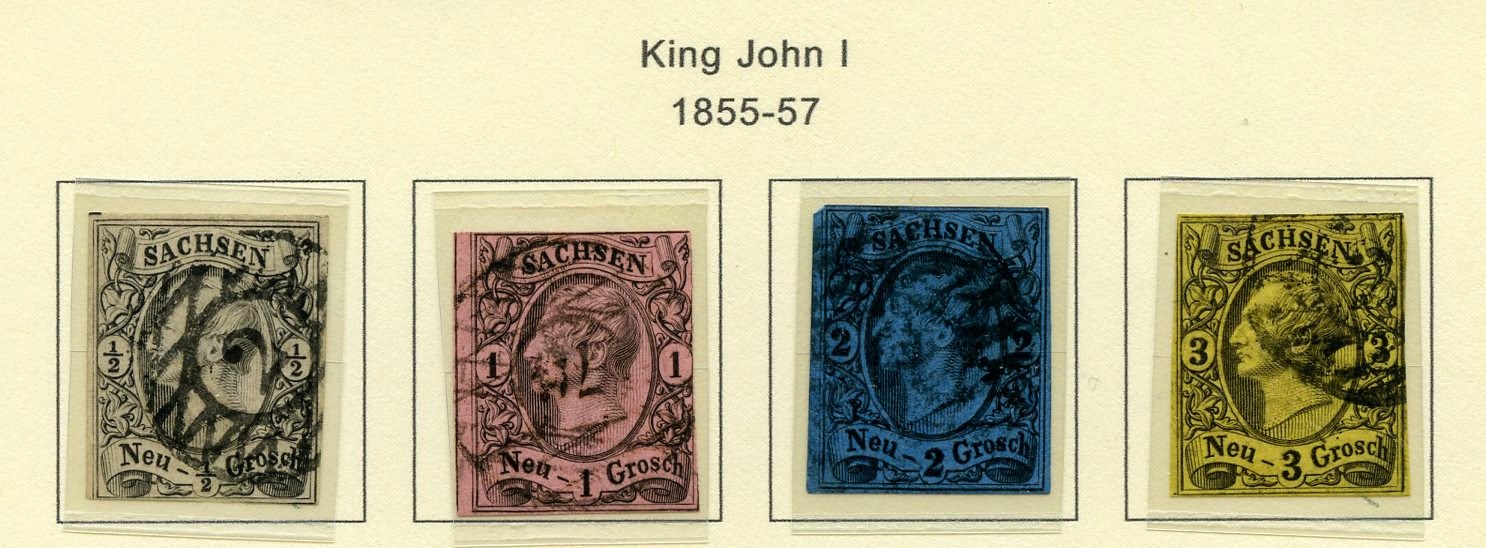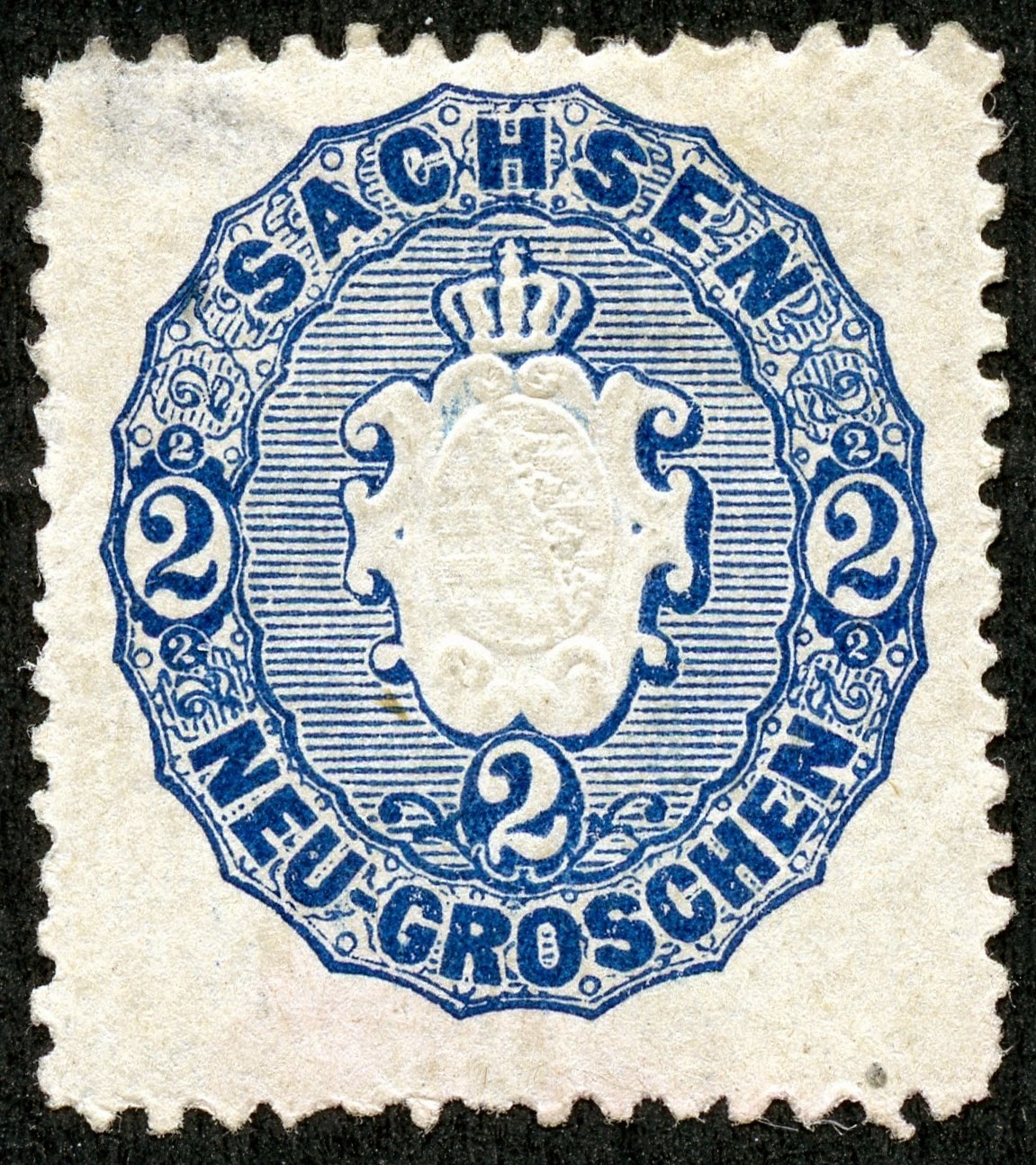1851 Scott 8 3ng black/yellow
Frederick Augustus II
Quick HistoryThe Kingdom of Saxony lasted between 1806 and 1918, although the Kingdom existed as a more slender state after 1815 (Prussia took the rest), and then joined the German Empire in 1871.
The Kingdom of Saxony after 1815 (Green)
Territories annexed in 1815 by Prussia (Light Green & Blue)
King Frederick Augustus I almost lost his throne in 1815, as he had the Saxons aligned with the French rather than the Prussians. But Prussia decided to take only 40% of the Kingdom, including Lutherstadt Wittenberg, home of the Protestant Reformation, and left the King to rule the rest, which did include Dresden (the capital) and Leipzig.
Population was about 2,500,000.
A stamp was introduced in 1850, and it looks quite similar in design to the early "Numeral" stamps of Bavaria. I won't be showing this one as the CV is north of $7000. ;-)
Other designs (1851- 1863) show the "Coat of Arms", and the Kings Frederick Augustus II and John I. We will see more of these presently.
The German Empire 1871: Saxony (Brown) is in the lower center
Of interest, during the 1866 Austro-Prussian War, Saxony allied with Austria. Perhaps, as recompense, the Kingdom joined the Prussian dominated North German Confederation in 1867.
Stamps of Saxony were replaced by those of the North German Confederation on January 1, 1868.
Subsequently, the Confederation was reorganized in 1871 into the German Empire , under the leadership of Prussian Wilhelm I (Emperor) and Otto von Bismarck.
However, the King of Saxony (John I at the time) still retained some prerogatives, including establishing diplomatic liaisons with other countries.
A historical tidbit... Because the Kings of Saxony accepted the crown of Poland in 1697 (This lasted until 1763), they remained Roman Catholic, although the citizens of Saxony were 95% Protestant.
1865 Scott 11 2ng black/dark blue
King John I
Into the Deep BlueThe 2014 Scott Classic Specialized 1840-1940 catalogue has, for Saxony 1850-1863, twenty major number descriptions. Of those, eight are CV $1+-$9+, or 40%. Three more can be picked up for CV $10+. The stamp issues consist of imperforate (1850:1, 1851:1, 1851-52:5, 1855-60:6), and perforate 13 and embossed (1863:6). Many of the stamps also come as minor numbers in variant colors.
A closer look at the stamps and issues
10 Pfennings = 1 Neu-Groschen
30 Neu-Groschen = 1 Thaler
1851 Scott 5 1ng black/rose
Frederick Augustus II
The first 3pf brick red stamp, issued in 1850, has a "Numeral" design, and is very expensive (CV $ 7,000+). I will say no more about it.
There was also an 1851 3pg green issue stamp with a "Coat of Arms" design (CV $90+).
The 1851-52 issue (illustrated above) has five stamps, and shows King Frederick Augustus II in the vignette. Three of the stamps have a modest (for Saxony) CV of $9+-$20+.
Frederick Augustus II of Saxony
Frederick Augustus ruled from 1836 to 1854.
He was an intelligent King and ruled wisely.
In 1844, he was a guest of Queen Victoria and Prince Albert, and he purchased in England an ichthyosaur reptile skeleton for his natural history collection.
He died accidentally in 1854 when he fell in front of a horse who stepped on his head.
1855 Scott 9 1/2ng black/gray "King John I"
As Frederick Augustus II had no legitimate issue, his brother, John (Johann) assumed the throne.
Between 1855-60, a six stamp issue was released with his portrait. CV ranges from $4-$10+ for four stamps.
He remained as King until his death in 1873, two years after the Kingdom had become part of the German Empire.
Like his brother, he was intelligent and enlightened. He translated into German Dante's Divine Comedy.
Between 1855-60, a six stamp issue was released with his portrait. CV ranges from $4-$10+ for four stamps.
King John I (1870 Portrait)
John's (Johann's) full name BTW was Johann Nepomuk Maria Joseph Anton Xaver Vincenz Aloys Franz de Paula Stanislaus Bernhard Paul Felix Damasus.He remained as King until his death in 1873, two years after the Kingdom had become part of the German Empire.
Like his brother, he was intelligent and enlightened. He translated into German Dante's Divine Comedy.
1863 Scott 16 1/2ng orange "Arms Embossed- Design A5"
The next (and last) issue for the Kingdom of Saxony was an 1863 six stamp production with a "Coat of Arms" center design, which is embossed. CV is less expensive unused, and ranges from $1+-$4 for five stamps.
Two stamps have the "A5" frame design.
Two stamps have the "A5" frame design.
"Coat of Arms of Saxony"
The "Coat of Arms" for Saxony is from the House of Wettin, which was founded in the early 10th century. The House of Wettin was divided into two ruling branches in 1485 by the Treaty of Leipzig. The Saxony rulers, who also played a part in Polish history, were the Albertine branch.
1863 Scott 19 3ng red brown "Arms Embossed- Design A6"
1863 Scott 19a 3ng bister brown
The other frame design, found on four stamps for the 1863 issue, is shown here.
An aspect of Saxony stamps in the Scott catalogue are the not infrequent minor numbers for color varieties.
Shown above is the major number "red brown", and a minor number "bister brown" hues.
An aspect of Saxony stamps in the Scott catalogue are the not infrequent minor numbers for color varieties.
Shown above is the major number "red brown", and a minor number "bister brown" hues.
1863 Scott 20c 5ng slate
"Arms Embossed- Design A6"
Another example of a minor number color is the 5ng slate shown above. The major color in the Scott catalogue is dull violet.
Deep Blue
1855-60 Issue in Deep Blue
Deep Blue (Steiner) has two pages provided for Saxony, and have a space for all the major numbers.
Of interest, Deep Blue has the "King John I" stamps labeled as an 1855-57 issue, but the 2014 Scott 1840-1940 catalogue lists minor number color variants through 1860.
1863 Scott 15 3pf blue green
Arms Embossed
Big Blue
Big Blue '69 has Saxony on one line of one page, and includes eight spaces for the "1855-56" (3 spaces) and 1863 (5 spaces) issues. The 1940s editions have the same coverage. Total coverage is 40%.
Saxony page in one of the 1940s editions
Actually, the "1/2ng" cut for the "1855-56" spaces is from the 1851 issue. Therefore, for the "1855-56" issue, I include as choices stamps from the 1851-52 issue.
With the additional issue admitted, BB covers the inexpensive stamps well. However, the 1855 Scott 9 1/2ng black/gray (CV $4) is not given a space: for, as just mentioned, they show - by mistake? - the 1851 Scott 3 1/2ng black/gray cut (CV $10+). The only other moderately expensive stamp that was not included as a choice is the 1855 Scott 2ng black/dark blue @ CV $10+.
For the spaces in BB, there are only two that require CV $10+ stamps.
Checklist
1855-56 (actually 1851-60*)
3,5 or 10,8 or 12,
1863
15,16,17,18,19,
Comments
A) Expensive stamps ($10 threshold):
1851 Scott 3 1/2ng black/gray ($10+)
1855 Scott 12 3ng black/yellow ($10+)
B) *1851-60 - See discussion above regarding the additional coverage.
1863 Scott 18 2ng blue "Arms Embossed"
Out of the Blue
Without a doubt, the "German" stamp sphere would be an interesting one in which to sub-specialize. But I can't let go of all the other classical WW areas. I guess I'm constituted to be a "generalist". ;-)
Note: Map images, King portrait images, and "Coat of Arms" image all appear to be in the public domain.
Have a comment?
















What may be of interest is that the kingdom of Saxony also provided the postal services for the neighboring duchy of Saxony-Altenburg and thus the stamps of Saxony were used there. Saxony-Altenburg is one of the Thuringia duchies that were until 1815 part of Saxony.
ReplyDeleteThanks for that tidbit Gerben.
DeleteIf you think there is an error in Deep Blue labelling, Bill is happy to respond to correction requests.
ReplyDeleteWell, its a minor problem having to do with the issue having minor numbers through 1860, but the major numbers are O.K. with the labeling.
DeleteI recently acquired a number of German States stamps, including a cancelled Sachsen Drei and a mint obvious duplicate. I am interested on how to identify if the stamp is real or not.
ReplyDeleteThe best site I know for forgeries is Nelson's (from Canada) forgery site.
DeleteCheck out his Saxony..
https://stampforgeries.ca/german-states/saxony/